Source: Digital Asset Research, compiled by Shaw Gold Finance
To be honest, I've seen enough of the four-year cycle theory, so today I'm going to rant about why those who follow this theory will ultimately fail miserably.
These people have never studied time or cycles in their lives, yet they are convinced that the four-year cycle must be completed. They have no idea what they are dealing with and will ultimately be forced to buy at higher prices.
This is an argument based purely on data, not some random guess. I am just fed up with the overwhelming pessimism and undue caution in the market, which makes me very optimistic.
I don't mean to exaggerate what this market might do, but this sentiment alone is enough for me to assert that I've had enough of this nonsense. We will continue to rise, longer than the time these people can keep their sanity.
A bull market does not peak when everyone is ready to take profits and walk away. It peaks when people are scrambling to leverage up, mortgaging properties to buy more stocks. It peaks when those simple-minded friends/neighbors/cousins or uncles of yours are making a killing far beyond their abilities and then quit their jobs to become investment professionals. It peaks when no one, I mean no one, is bearish anymore.
The current situation is vastly different from that time; whenever the S&P 500 drops 3%, investors flee the market; or the entire cryptocurrency world plans to sell off in the next three months, based on some cycles they fabricated out of thin air, with no solid data to support it.
What these new cycle experts do not realize is that the quality of a cycle depends on the underlying conditions that form it.
"The map is not the territory" comes to mind at this point.
This means that while you can keep looking at the map, it can only give you a rough idea of where you are. The map will not tell you there is a big hole 300 feet to your left. It won’t tell you there is a giant oak tree in the middle of the field. It won't tell you there is an abandoned shed a mile ahead. Of course, it won't tell you that the temperature outside is 110 degrees Fahrenheit with 50% humidity. Or whether you are in a jungle or a deciduous forest.
A map will show the coordinates and direction of your location, but it cannot make you perceive actual objects, environments, and terrains, which are what you might encounter while navigating.
The cycle is a map that provides us with a time frame and historical data to give us a rough idea of what we usually see, but the conditions behind the market are the real reality.
These conditions determine the expansion, contraction, volatility increase, volatility decrease, and so on of the cycle.
The cycle we are currently in is fundamentally different from the previous three cycles in terms of conditions, and we will analyze in detail the reasons for this and how it is reflected in the charts. There is a key distinction between "this time is different" and "it's the same old story but with some differences."
Price structure and behavior.
From the very start of this cycle, we can clearly see that the market structure and behavior are different from previous cycles. The reason is that new assets and markets will go through different growth and adoption phases. This reminds me of Peter Lynch's view that a company's style changes over time.
Companies are not always high-growth enterprises. Over time, they can transition into slower growth companies, but they will become the mainstay in the industry.
This is a typical adoption cycle where the first phase is a hype cycle, the second phase involves growing pains and uncertainties, and the final phase is the beginning of mass adoption, with early users starting to dominate.
Let's look at the case of Amazon, including its lifecycle and market structure, and compare it with Bitcoin and Ethereum.
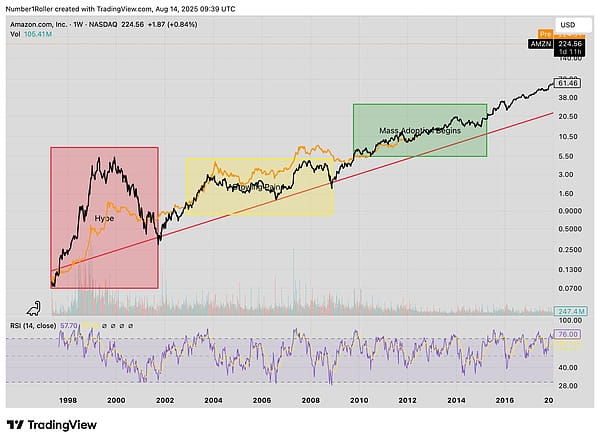
Similarly, ETH is shown below.
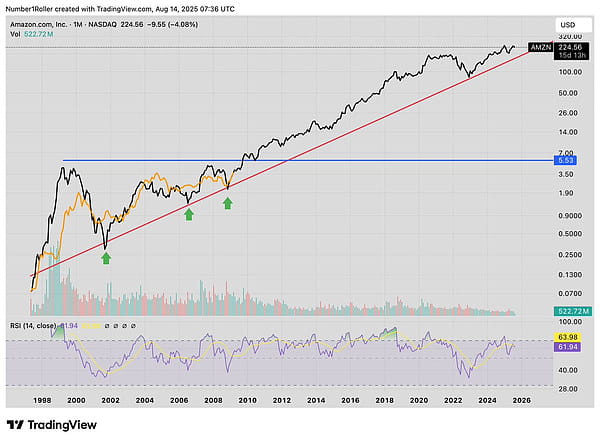
This is the argument we made during the market crash in the first quarter a few months ago.
We show a close relationship between Amazon (AMZN)'s current structure and behavior and what we are currently witnessing in major cryptocurrencies.
Clearly, the cycle in early 2017 was driven by a lot of hype, similar to Amazon in 1999. Then, the bull market in 2021 was structurally more like sideways consolidation rather than a significant expansion. This was the key test of whether the asset could survive the crash in 2020 and the bear market in 2022 to prove its worth.
Similarly, Amazon (AMZN) only set a historical high after 2008. It went through a long struggle to prove that it survived the bursting of the internet bubble and was indeed capable of building a long-term viable business.
Finally, we have entered the phase of mass adoption, where the majority of early groups are starting to join in. This is the last hurdle for Bitcoin and cryptocurrencies as an asset. The last argument once raised—"What if the government bans it?"—is no longer valid. The government has not only not banned it but has gone to great lengths to embrace it. This is precisely the typical development process of the adoption curve.
Okay, that's great, we know we are in a phase of mass adoption, but what does that have to do with the four-year cycle?
Dow Jones
Let's take a step back and look at the Dow Jones index. The Dow Jones index is undoubtedly the favorite chart of any serious analyst, as its price history on Trading View dates back to 1896. With over 100 years of data, this is the highest quality dataset we can rely on.
Looking back at the one-year chart of the Dow Jones index, we can find that there have been three consolidations lasting over ten years in its history. After the first two consolidations, its expansion period lasted about 17 to 23 years. The most recent consolidation occurred from 2000 to 2013. Currently, this rise has only lasted 16 years; if this is the top, it will be the shortest in history.
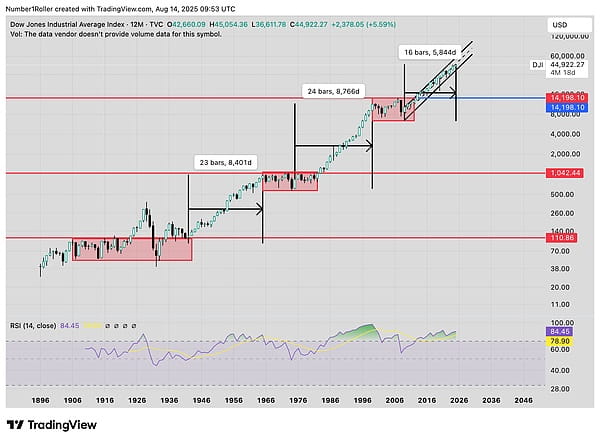
If we take a close look at this 16-year bull market that began from the 2008 low, we can see that there have been four times it retested the previous high.
The bottom in 2015 was a retest of the top in 2008. The bottom in 2020 was a retest of the top in 2015. The bottom in 2022 was a retest of the top in 2020. And the recent bottom in April was a retest of the top in 2022.
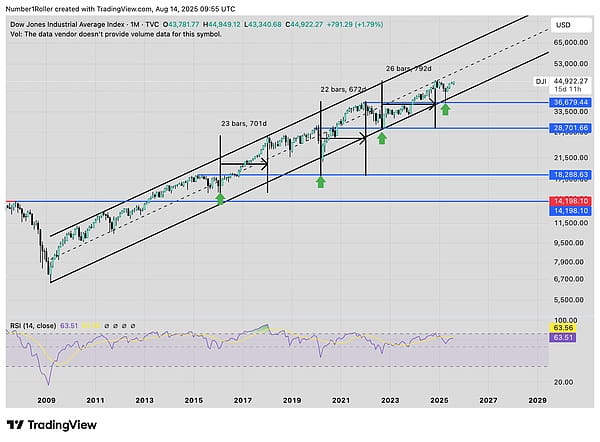
The market is precisely like a clock, constantly turning previous tops into support levels while moving up along this bull market channel. However, the key is the time the market takes to rise after each pullback. From the above chart, the shortest rising cycle is 22 months. Currently, from the low in April, we have only risen for 5 months. If we calculate based on the shortest 22-month rising cycle, the market will peak in early 2027.
This is another great data point that shows you why I think the entire market is worth being optimistic about for at least the next 12 months. In this environment, it is hard for me to believe that cryptocurrencies will collapse while stocks continue to rise.
From bull to bear and then back to bull.
Another reason I am convinced this bull market has just begun is the crash in April.
I think people do not fully realize the level of panic the last crash brought to the stock and cryptocurrency markets. We are talking about market sentiment, time, and prices, all at severely bearish levels.
The readings we see are comparable to the oversold levels and panic seen in 2020, 2008, and 2000. The market is completely collapsing.
This actually provides the momentum needed for this market to initiate a new bull market, the duration and strength of which will exceed everyone's expectations.
Look at Ethereum (ETH). Ethereum's crash lasted longer than the FTX collapse, and the price drop was almost the same. In my view, this marks the end of a bear market that began at the market top in 2024. We formed a triple top in the last rally in November, followed by a bear market lasting over 50 weeks, ending with that collapse.
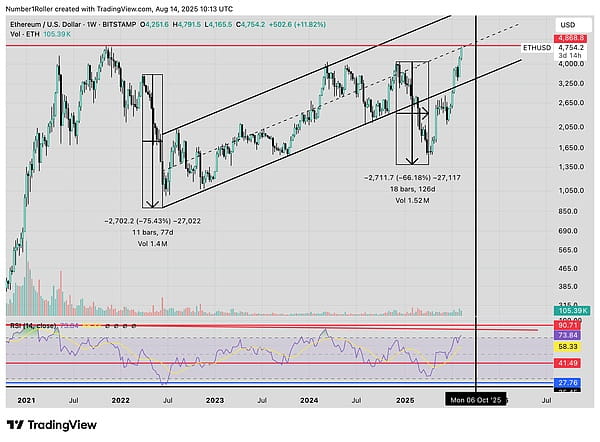
The reason supporting this view is that Ethereum (ETH) has actually gone through a complete bull market. A typical bull market lasts between 90 to 120 weeks. Subscribers know the importance of these time factors.
Interestingly, from the low in 2022 to the high in early 2024, it is exactly 90 weeks. In other words, I believe that was a quietly completed full cycle, followed by a bear market cycle that lasted exactly one year (similar to other bear markets), ending with the collapse in April.
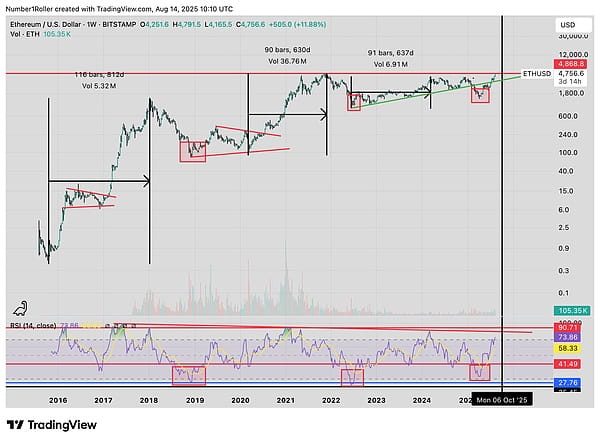
Just look at the relative strength index (RSI) readings in the chart above. The weekly RSI has only reached these levels three times, and all three were bear market bottoms. The low in April corresponds to a bear market bottom, providing us with ample room for upward movement.
Copper/Gold Ratio
This is a great market correlation chart provided to me by Bravos Research.
This is the copper/gold ratio chart, which has been predicting Bitcoin's parabolic moves and cycle tops since 2013.
Every time this chart bounces back, Bitcoin starts its most rapid expansion. Then, when it peaks, Bitcoin also remains high.
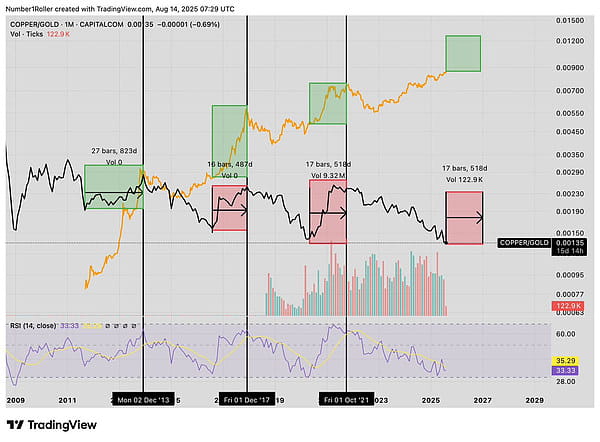
I find this chart very interesting for two reasons. Aside from the correlation (which I've seen the most obvious), the timing aspect is also intriguing. This chart is currently at a low point, and assuming it is bottoming out, a typical bull market cycle lasts 17 months.
From today, 17 months later, which is early 2027, aligns with the situation of the Dow Jones index I just showed you.
It will not only continue to rise for 17 months but will also coincide with the biggest phase of the Bitcoin bull market, which is allegedly not even begun yet.
By the way, I want to show you data from Stansberry Research that highlights the short positions on Bitcoin in traders' commitments.
Currently, our level of bearishness has reached the highest level since 2021.
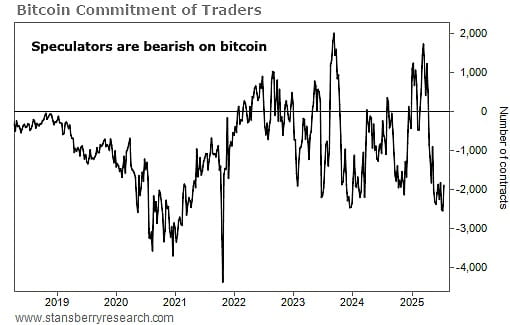
Stansberry's data continues to indicate that whenever the COT reaches a new extreme one-year bearish level, the subsequent price movements show the following.

This is only six years of data, but based on this, it suggests that by this time next year, Bitcoin could soar to $230,000, which again indicates that the cycle will be longer based on this extreme reading.
Altcoins
Next up are altcoins. I don’t have much to say about altcoins, I just feel that the outlook for a major market movement in the altcoin market is very bright. However, significant market fluctuations take time, as you can see; if these fluctuations need time to complete, then the four-year cycle is meaningless.
Look at the 'other' charts below; if you think there are any bearish signals, you cannot call yourself an analyst. Just based on this structure, you can have extremely optimistic expectations for altcoins.
Additionally, we know that the longer it takes for the market to break old highs, the greater the magnitude of the fluctuations.

Once this situation erupts, it is hard to say how far it will develop, but I highly doubt it will end after just 8 weeks after nearly 5 years of brewing.
From the comparison of TOTAL3 with BTC below, we can roughly understand some of the time required. Not only has it just started and not yet broken through, but the typical running cycle is 12 to 13 months, meaning we won’t see results until the second half of next year.
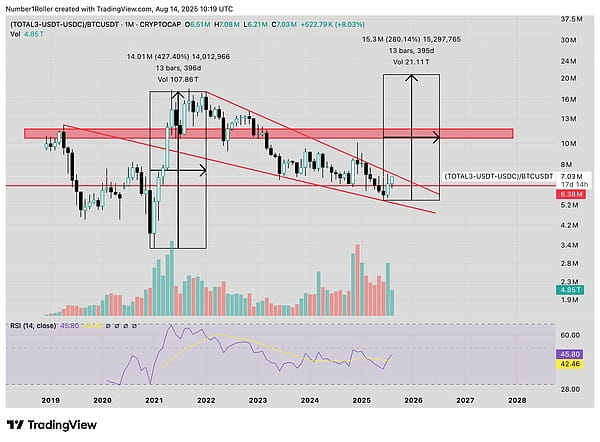
Then a quick look at the overall 'other' charts reveals the same situation, but over a longer time span. The difference with this recent bear market is that it has lasted longer than ever before. So when it breaks out, we should expect a significant rise, and more importantly, it will last a long time.
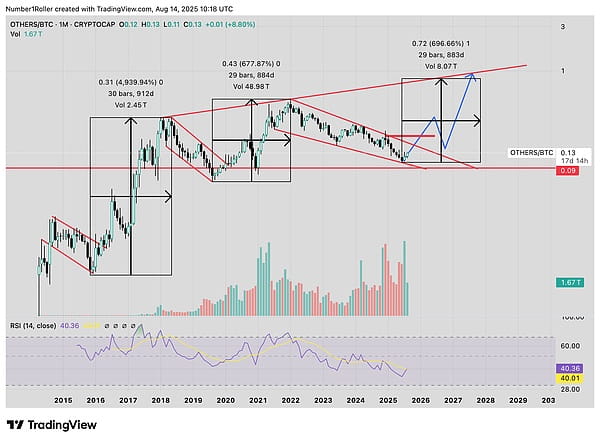
You can't seriously analyze any of the charts above and conclude that the breakout will end in eight weeks. Based on these charts, we expect the upward trend to last 12 to 18 months.
Halving Theory
Finally, let's talk about the halving theory. To my understanding, this is precisely the fundamental reason for the four-year cycle narrative, right?
If the halving theory is correct, then why did we set a new ATH before the halving in 2024? According to this theory, we should have only set a new ATH after the halving.
And why did we crash in the first quarter of the fourth year of the four-year cycle? That has never happened before. But everything is still the same, isn't it?
It seems to me that many cracks have appeared, but these people are like bears in a bull market, refusing to give up and unwilling to accept the facts.
Here is a novel idea proposed by the famous BTC OG Adam Back, who was even quoted in the Bitcoin white paper.
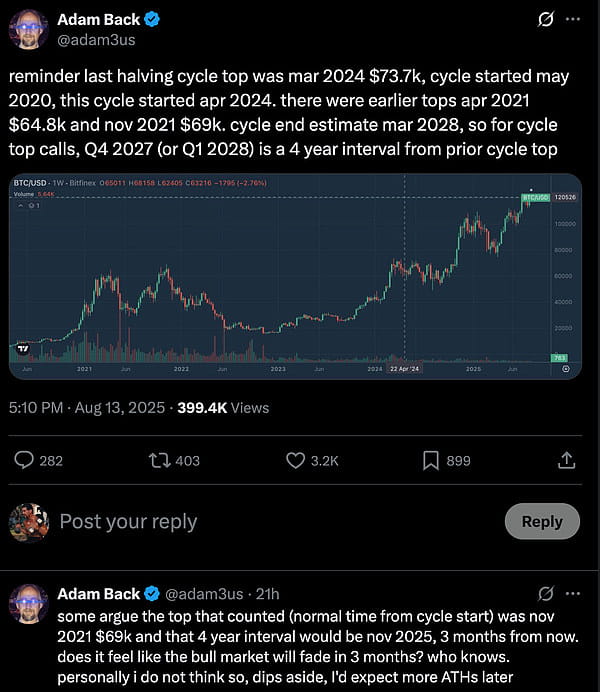
He points out that the cycle top is actually in April 2024, because technically, that is the peak of the halving cycle, and the next halving cycle will end in mid-2028.
An interesting point, and in my view, reasonable. This does not mean Bitcoin will not experience pullbacks before 2028, or that 2028 is the cycle top target I believe; it simply indicates that the halving does not actually affect Bitcoin's price.
Here is a view of Bitcoin halving and cycle tops.
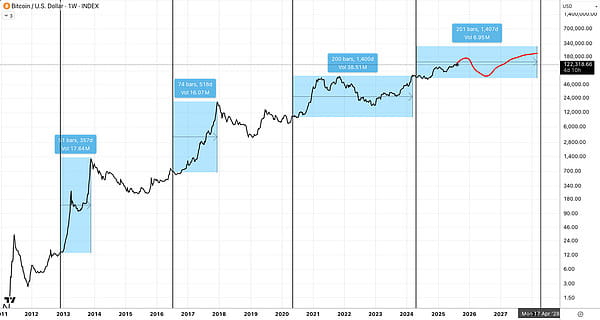
To summarize
This statement is indeed a bit exaggerated, but I strongly believe that there is a lot of data indicating this four-year cycle of cryptocurrency will not end. In my view, the current contrarian perspective is clear: both stocks and cryptocurrencies will rise significantly and last longer.
Even though everyone is worried about the four-year cycle and overvaluation, I suggest taking a good look at the actual data and facts to support this worry.
Any market veteran can tell you that the current market sentiment is simply not enough to support a market top.
With Ethereum not yet at a new high and altcoins on the verge of breaking out of a four-year consolidation range, too many people are ready to sell at any moment, while the market tells us, from the Dow Jones index and copper-gold ratio, that the upside potential is much larger than people think.
As I mentioned a few days ago on X, long cycles are harder, not easier. And because people think we are still in the early stages, the cycle won't last too long, because then they would make a killing. That's not the case. The longer the cycle, the greater the chances of people losing.
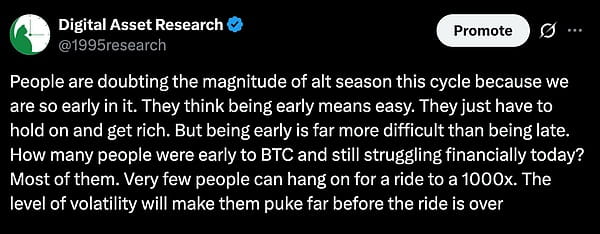
Not many people consider the fact that Ethereum actually went through a complete bull market from the low on June 22 to the high on April 24, followed by a whole year of bear market. From the perspective of time, price, and market sentiment, all this indicates that this view is accurate, but most people have overlooked it.
Worry, fear, and doubt will continue to drive this bull market to last far longer than anyone expects. Most are trapped by the fact of the four-year cycle, which adds another log to this fire.
Remember, the market will do everything it can to deceive as many people as possible.
Even though we are entering a long bull market, that doesn’t mean the process will be smooth sailing. There will be declines, pullbacks, and corrections that could even confuse the most experienced veterans. Having a framework to understand market conditions is crucial for helping you find the right position that many investors are struggling to identify.

